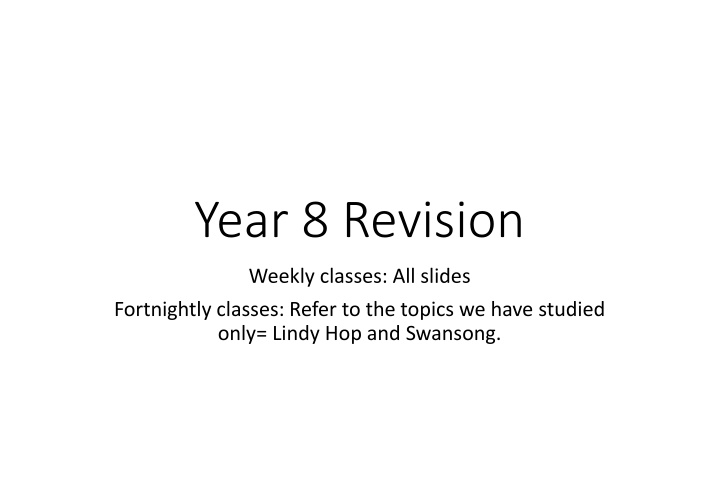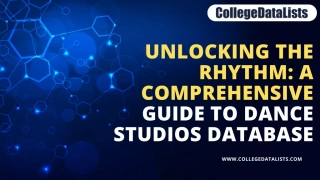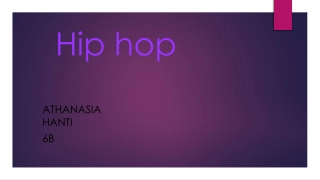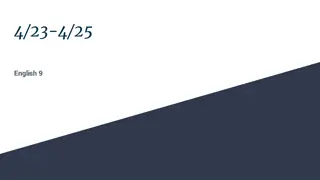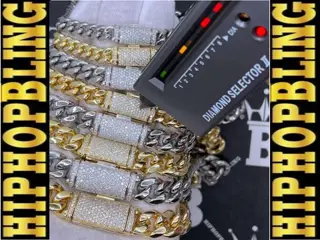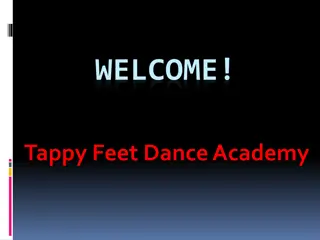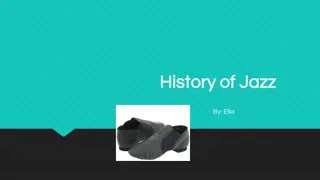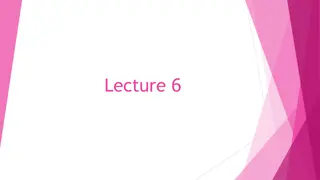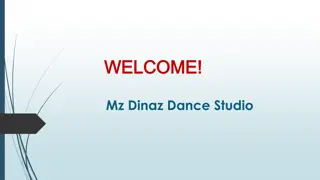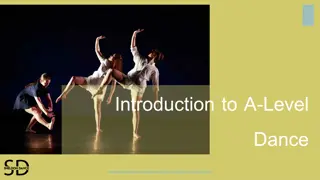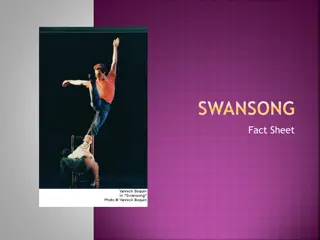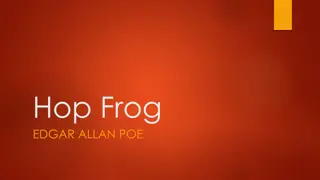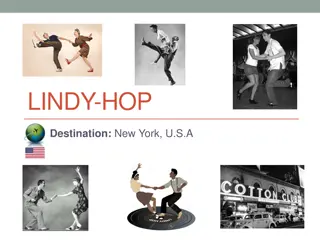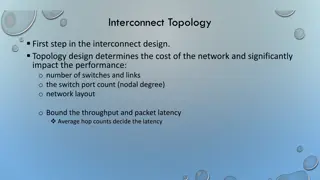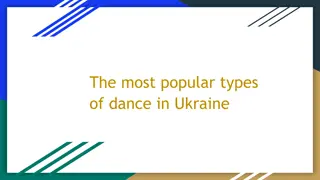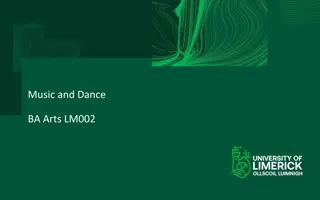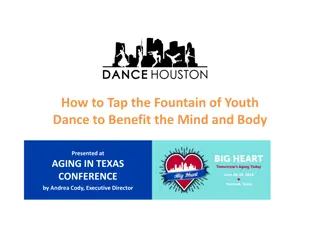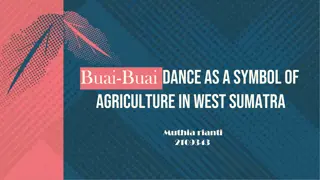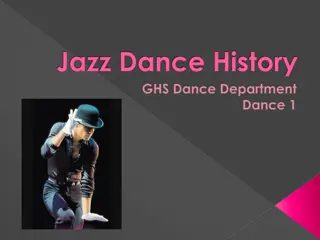Year 8 Dance Revision - Lindy Hop and Swansong
Dive into the world of dance with Year 8 students focusing on Lindy Hop key movements and elements like energy, extension, musicality, focus, formations, transitions, and more. Explore the historical significance of the Lindy Hop dance style in Harlem during the 1920s and 30s, along with other dance forms like Charleston and tap. Enhance your choreography skills, understand dance structure, and improve your performance through various dance techniques.
Download Presentation

Please find below an Image/Link to download the presentation.
The content on the website is provided AS IS for your information and personal use only. It may not be sold, licensed, or shared on other websites without obtaining consent from the author.If you encounter any issues during the download, it is possible that the publisher has removed the file from their server.
You are allowed to download the files provided on this website for personal or commercial use, subject to the condition that they are used lawfully. All files are the property of their respective owners.
The content on the website is provided AS IS for your information and personal use only. It may not be sold, licensed, or shared on other websites without obtaining consent from the author.
E N D
Presentation Transcript
Year 8 Revision Weekly classes: All slides Fortnightly classes: Refer to the topics we have studied only= Lindy Hop and Swansong.
Subject: Dance Year 8 Term: Autumn. Half term 1. Topic: Lindy Hop Key Words Key movement Jazz Walks/ shaky hands Walks with a bounce with arms at either side of the body with hands splayed 1 1 Energy The strength required for sustained physical activity A physical performance skill that should be demonstrated in rehearsal and performance Around the clock Three kick hops to do a full turn either right or left. Two steps back and one step forward to end on the opposite leg. 2 Charleston Step forward tap toe at the front, step back and tap toe behind. To increase difficulty lean forwards and back and add a bounce to the steps. 3 2 Extensio n Lengthening one or more muscles/limbs. A physical performance skills that is shown best in both arms and legs. A physical performance skill that is developed through listening to the music and picking out the key parts. A physical performance skill that when used effectively can help to communicate the mood of a dance A choreography tool- RELATIONSHIPS- that creates different effect in a group dance A choreography tool STRUCTURE- that helps a dance to have a seamless effect and helps to structure the choreography A choreography tools in relation to SPACE, creates order for a dance. A choreography tool that demonstrates unity, timing and enhances a dance idea. Spank the baby Pivot around on one leg, one arm is high at the side of the head, bent at the elbow. The other hits your hip as you pivot. 4 3 Musicalit y The ability to pick out the unique parts of the music. Fall off the log Jump on to one foot with a tilt/ lean of the torso. Step the free leg behind, side and then jump feet together to repeat on the opposite side. 5 Flick kicks Kicks from below the knee with a pointed foot. Usually done with a hop in between to create a bounce. 6 4 Focus Use of eyes to enhance performance. Scarecrow/ Frog On the balls of the feet, bend knees and invert both so they are touching in your centre line, arms above head with wrists inverted and touching. Jump from this position to the frog position where you are crouched on the floor, with both knees now facing out in turn out and with hands on the floor in front of you. 7 Shorty Georgie's Pushing between the balls of your feet in a parallel position *3- e.g. Right/ Left/ Right. As you push between feet, first two fingers together are held on each hand and pointed up to the ceiling. Switch the arms as you do the legs, e.g. Right/ left right. Head turns sharply to right, left and then back to the audience. 8 5 Canon The same movement repeated one after the other Suzie Ques Feet in parallel, bend knees. Twist to the right moving your hells, toes, heels and then repeat to the left. 9 6 Transitio ns Movements to link between sections/ movements Boogie in and out Jumping forwards and back, clapping hands in front and behind the body. 10 Texas Tommy A rocking step that can be done individually or with a partner. Rock from one foot to the other (back/ forward), triple step (3 steps) that move you to another area of the room or you can turn it. A complete Texas tommy is doing this twice. 11 7 Formatio ns A shape/ space in which you stand in with your group, e.g. a square Performers doing the same movement at the same time The shim sham Originally a tap dance step. A slide out of R/ L/ R/R in a single, single, double. This has a bounce in the knees and the foot slides back to a parallel position. 12 8 Unison Spinning Top Partner work. Hold hands with a partner, cross hands right over left. Stage 1: standing- open and close arms whilst stood opposite each other, one person turns as the arms open and close. Stage 2: Complete stage one. Now do small running steps to spin around as you turn one person. Stage 3: After mastering stage 1 and 2, now drop to a seated position on the floor and complete the turn with one person stood overthe other. Partner work. One person ducks down, in a low position, with head and elbow tucked in. The other person, runs towards their partner, jumps in parallel just behind their tucked position, pushes in the middle of their partners back then straddle jumps over the top of them. To increase difficulty, the level of the tucked position can gradually get higher. 13 Contextual knowledge The lindy Hop (or Lindy) is a partner dance that originated in the 1920's and 30's in Harlem, New York. The dance itself consists of both 6 and 8 count steps and it includes footwork borrowed from the Charleston and Tap. The Lindy Hop is considered a cultural phenomenon that broke through the race barrier when segregation was still the norm. Although the history of Lindy may be muddled, it is certain that it was born from the blending of African rhythms and movements with European structured dance. In New York City, ballrooms dominated Harlem, but one, the Savoy was to become the king of swing. Lindy flourished there, partly because it was one of the few racially integrated ballrooms where White and Black people could dance, be inspired and share moves like no other place. Leap Frog 14 Kick through the legs Partner work. In a pair, one person is behind the other. The front person does a star jump, whilst the person behind holds their hips and lifts them whilst they do a start jump. Whilst the front student is in the air, the back person kicks one leg through the others legs. 15
Subject Dance Year 8 Autumn: Half term 2 Topic: Olympics Key Words 1 Retrograde A movement phrase done in reverse order A choreography tool ACTIONS- that develops a phrase to create a different effect when it is executed in the original order at the same time. A choreography tool RELATIONSHIPS- that creates different effects in a group dance A choreography tool- ACTIONS- The 6 basic actions used as much as possible to create variety in a dance piece A choreography tool- SPACE-that can create different effects in a dance piece A choreography tool ACTIONS- that develops a phrase to create a different effect when it is executed in the original format at the same time. A choreography tool- ACTION- The addition of a movement/ section to an otherwise repeated moment A choreography tools- ACTION/ STRUCTURE. This helps to communicate the dance idea/ theme to the audience and highlights important moments. A choreography tool- ACTIONS- This helps to show a dance idea by repeating some movements but in a different order- Used to create different effects. Key movements 1 Elevate Jump/ hop/ leap 2 Canon The same movement repeated one after the other 6 basic dance actions: Elevate/ Fall/ Gesture/ Stillness/ Travel/ Turn Changing the size of a particular movement Also know as instrumentation. Use of different body parts to execute a movement Adding a movement on to a movement phrase of section 2 Fall Movementaway from your centre body line Movement that does not hold any weight, e.g. an arm movement, head nod, shoulder shrug A movement of still ness to create an effect, this is usually done in a particular position to highlight the theme/ story of the dance but can also show the physical skill of balance. Ways of moving across the space/ turn/ run/ hop/ roll/ cartwheel/ jump/ lift A change of direction when moving, e.g. / or full turn. 3 EFGSTT Gesture 4 Size 5 Different Body parts 4 Stillness 6 Addition 7 Reprise The repetition of an earlier moment in the phrase/ dance piece 5 Travel 8 Fragmentation Re ordering movements in a short section of a dance 6 Turn 9 Dynamics The speed of a dance A choreography tool that can be used to create different effects and change the speed throughout your dance A choreography tool- RELATIONSHIPS- that adds contrast and gives different effects to a dance ARCHERY ATHLETICS BADMINTON BASKETBALL BEACH VOLLEYBALL BOXING CYCLING ROAD DIVING FENCING FOOTBALL GOLF GYMNASTICS ARTISTIC HANDBALL HOCKEY JUDO ROWING RUGBY SHOOTING SWIMMING SYNCHRONIZED SWIMMING TAEKWONDO TENNIS TRAMPOLINE VOLLEYBALL 10 Mirroring Movement executed with a partner as if in a mirror image 11 Contrast Contrasts in your movement such as high/low, big/little A choreography method where the order of the movements is determined by chance e.g. by a dice. A choreographic tool where dance elements are altered to create oppositions A choreographic creative tool that adds variety to a dance piece 12 Chance method
Subject Dance Year 8 Spring: Half term 1 Topic: Capoeira Key movements Key Words 1 Dynamics HOW you execute a movement, the speed at which you move A choreography tool- DYNAMICS-. The use of various speeds in a dance piece helps to create different effects, e.g. fast, slow, heavy, sharp. A choreography tool RELATIONSHIPS- that creates different effects in a group dance A choreography tool- ACTION- Can also be referred to as call and response. Is used almost exclusively in Capoeira so it creates the effect of a fight between two dancers. 1 Jinga The basic step in Capoeira, step to the side, step back and then rock forward on the opposite foot. A form of cartwheel, used for defence or attack 2 Au 2 Canon The same movement repeated one after the other A movement is executed to another member of your group and another movement is done in response to this e.g. a kick and then someone steps/ moves out of the way. Changing the size of a particular movement Also know as instrumentation. Use of different body parts to execute a movement 3 Action and Reaction 3 Esquiva a side lunge, used for defence 4 Ponteira a front kick, used for attack 5 Cocorinha a drop to the floor, used for defence 4 Size A choreography tool- SPACE-that can create different effects in a dance piece A choreography tool ACTIONS- that develops a phrase to create a different effect when it is executed in the original format at the same time. Used a lot in Capoeira. Ducking and diving helps to create the effect of a fight between two dancers. 5 Different Body parts 6 Plank A held press- up position either forwards or can be to the side balancing on both arms or one if to the side. A change of direction when moving, e.g. / or full turn. 7 Turn 6 Duck and Dive Use of different movements to move out of the way of oncoming movement from your partner The repetition of an earlier moment in the phrase/ dance piece 8 Barrel- Turn A turn that involves casting the arms up and leaping into the air and rotating 360 degrees while in the air One hand on the floor close to the same leg so you are folded in half. Using your leg and arm as an axis you can spin with the opposite leg in in the air, or just kick and stand. The high leg must have a slight bend at the knee to resemble a scorpion s tail. A blocking and defence movement. A crouch to the floor with one leg outstretched in front of you 7 Reprise A choreography tools- ACTION/ STRUCTURE. This helps to communicate the dance idea/ theme to the audience and highlights important moments. A choreography tool- RELATIONSHIPS- that adds contrast and gives different effects to a dance 9 Scorpion kick or turn 8 Mirroring Movement executed with a partner as if in a mirror image 10 Negativa 9 Meeting and Parting Movement that is executed close together and then further apart form other group members/ dancers A choreography tool- RELATIONSHIPS- that adds contrast and gives different effects to a dance
Subject Dance Year 8 Spring: Half term 2 Topic: Swansong Key Words 1 Groupings Key movements Different use of dancers in a Dance piece The same movement repeated one after the other A choreography tool that demonstrates different RELATIONSHIPS, e.g. Solo, Duet, Trio A choreography tool that creates different effects in a group dance in relation to RELATIONSHIPS 1 Use of torso Use of the torso in various ways, e.g. tilts, curves, high releases A change of direction when moving, e.g. / or full turn. A sharp drop the floor in a crouched position 2 Canon 2 Turn 3 Drop 3 Question and Answer In a group, one dancer can execute a movement, with the remaining group members executing a different movement in response to this. Can also be referred too as call and response. Unison Performers doing the same movement at the same time A choreography tool that creates different effects and can help to tell a story of a dance. Demonstrates uses of RELATIONSHIPS in dance. 4 Crucifix lift Group work: 3 people. Person who is being lifted in the middle, their arms are out to the side at shoulder height with their legs together. The remaining two dancers lift the ,middle dance by their arms in a crucifix position. The weight of one dancer that balances another dancer in a still position that can be executed at different levels and with different body parts. Use of tap dance steps to reinforce the dance idea such as, stamp, brush foot forward and back, shuffle- sharp brush forward and back of one foot/ toe/ hell- digging of the toe or heel in to the ground to make a noise. Still images or silent tableaux used to illustrate a specific incident or event 4 A choreography tool that demonstrates unity, timing and enhances a dance idea. Demonstrates uses of RELATIONSHIPS in dance. 5 Counterbalance 5 Levels Distance from the ground- Low, Medium, High A portable object that is used in a dance, for example a suitcase Use of face to show mood. Use of dancers on different levels to support the character/ theme/ story A prop to enhance the story and/ or characters of a dance piece. An interpretative performance skill that helps to communicate a story/character/ theme/ mood. 6 Tap steps 6 Props 7 Facial expressions 7 Freeze Frames 8 Movement memory A physical representation of the memory of the movement of a dance The energy the dancer uses to connect with and draw in the audience. Making movements bigger to invite the audience in. A mental performance skill that exercises both the mind and the body. Use of repetitive rehearsal can improve this. An interpretative performance skill that is used to help portray a character/ mood or story. 9 Projection Contextual knowledge The famous dance piece choreographed by Christopher Bruce is the stimulus for this unit of work. The piece follows one dancer who goes through a series of different interrogations for something we do not know about. We are left wondering where this takes place, what the dancer has done and if they are indeed innocent. It shows the story of 2 V 1. It is a contemporary ballet piece which includes some tap steps. 1 0 Extension Lengthening one or more muscles/limbs. A physical performance skill that is shown best in both arms and legs. Command Words 1 How In what way or manner, by what means 2 Who Giving further information about a story, person or people 3 What Asking for information specifying one or more people or things from a definite set. 4 Why Giving a reason or explanation to support the answer of the question.
Subject Dance Year 8 Summer: Half term 1 Topic: Stomp the Yard Key Words 1 Canon The same movement repeated one after the other A choreography tool RELATIONSHIPS- that creates different effects in a group dance 2 EFGSTT 6 basic dance actions: Elevate/ Fall/ Gesture/ Stillness/ Travel/ Turn A choreography tool- ACTIONS- The 6 basic actions used as much as possible to create variety in a dance piece A choreography tool ACTIONS- that develops a phrase to create a different effect when it is executed in the original format at the same time. This unit uses the film Stomp the Yard as its stimulus. Steppin is also called blocking, a complex synchronized dancelike performance that blends African folk traditions with popular culture (Street Dance). Stepping involves clapping, body slapping, vocalizations, and dramatic movements that are done in different rhythm's and patterns. 3 Fragmentati on A movement phrase chopped up and re ordered 4 Reprise The repetition of an earlier moment in the phrase/ dance piece A choreography tools- ACTION/ STRUCTURE. This helps to communicate the dance idea/ theme to the audience and highlights important moments. 5 Cumulative canon A phrase of movement where dancers join in at various different points, e.g. starts a s a solo, then becomes a duet, then trio etc. A choreography tool- RELATIONSHIPS- that adds contrast and gives different effects to a dance. 6 Overlap canon A phrase of movement where dancers begin it at different points, instead of joining in with the dancer they go to the START of the phrase A choreography tool- RELATIONSHIPS- that adds contrast and gives different effects to a dance 7 Improvisati on Work created spontaneously or without preparation. A way to create movement that can be unusual/ innovative 8 Independen ce Self management to achieve something Using your own skills/ time management and thought process to bring an idea to life in dance 9 Stimulus A starting point of a dance A theme/ story or idea that you use as a starting point for your dance e.g. a film, a poem or a picture. A physical performance skill that is developed through listening to the music and picking out the key parts. 10 Musicality The ability to pick out the unique parts of the music. 11 Timing The ability to hear the bat in the music and move on time to this beat/ rhythm A physical performance skill that is developed through systematic repetition, use of the mirror and listening to the music. 12 Memory The retention of the dance movements, timing and rhythm of the steps A performance skill developed through various different types of rehearsal including systematic repetition.
